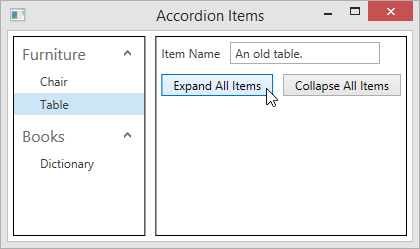This example demonstrates how to bind the AccordionControl to data using the AccordionControl.ChildrenSelector property.
The AccordionControl is bound to a data source. A panel on the right contains the dedicated Expand and Collapse buttons and allows editing a description of the currently selected item. A children selector and implicit data templates are used to build the accordion item hierarchy.
The image below shows the result:

Refer to the Data Binding topic to learn more.
View Example
using DevExpress.Xpf.Accordion;
using System.Collections;
using System.Collections.Generic;
namespace ChildrenSelector {
public class ViewModel {
public Data MyData { get; set; }
public object SelectedItem { get; set; }
public ViewModel() {
MyData = new Data();
}
}
public class Data {
public List<Category> Categories { get; set; }
public Data() {
Categories = new List<Category>();
List<Item> subitems = new List<Item>();
subitems.Add(new Item() { ItemName = "Chair", Description = "A red chair." });
subitems.Add(new Item() { ItemName = "Table", Description = "An old table." });
Categories.Add(new Category() { CategoryName = "Furniture", Items = subitems });
List<Item> books = new List<Item>();
books.Add(new Item() { ItemName = "Dictionary", Description = "My old French-English Dictionary" });
Categories.Add(new Category() { CategoryName = "Books", Items = books });
}
}
public class Category {
public string CategoryName { get; set; }
public string Description { get; set; }
public List<Item> Items { get; set; }
}
public class Item {
public string ItemName { get; set; }
public string Description { get; set; }
}
public class MySelector : IChildrenSelector {
public IEnumerable SelectChildren(object item) {
if (item is Category) {
return ((Category)item).Items;
} else return null;
}
}
}
<dx:DXWindow
xmlns="http://schemas.microsoft.com/winfx/2006/xaml/presentation"
xmlns:x="http://schemas.microsoft.com/winfx/2006/xaml"
xmlns:dx="http://schemas.devexpress.com/winfx/2008/xaml/core"
xmlns:dxb="http://schemas.devexpress.com/winfx/2008/xaml/bars"
xmlns:dxe="http://schemas.devexpress.com/winfx/2008/xaml/editors"
xmlns:dxa="http://schemas.devexpress.com/winfx/2008/xaml/accordion"
xmlns:local="clr-namespace:ChildrenSelector"
x:Class="ChildrenSelector.MainWindow"
Title="MainWindow" Height="350" Width="525">
<dx:DXWindow.Resources>
<local:MySelector x:Key="mySelector"/>
</dx:DXWindow.Resources>
<dx:DXWindow.DataContext>
<local:ViewModel/>
</dx:DXWindow.DataContext>
<Grid>
<Grid.ColumnDefinitions>
<ColumnDefinition Width="1*"/>
<ColumnDefinition Width="2*"/>
</Grid.ColumnDefinitions>
<Border Margin="5" Grid.Column="0" BorderBrush="Black" BorderThickness="1">
<dxa:AccordionControl Name="accordion" SelectionUnit="SubItem" ItemsSource="{Binding MyData.Categories }"
SelectedItem="{Binding SelectedItem}" ChildrenSelector="{StaticResource mySelector}">
<dxa:AccordionControl.Resources>
<DataTemplate DataType="{x:Type local:Category}">
<TextBlock Text="{Binding CategoryName}"/>
</DataTemplate>
<DataTemplate DataType="{x:Type local:Item}">
<TextBlock Text="{Binding ItemName}"/>
</DataTemplate>
</dxa:AccordionControl.Resources>
</dxa:AccordionControl>
</Border>
<Border Margin="5" Grid.Column="1" BorderBrush="Black" BorderThickness="1">
<StackPanel>
<StackPanel Orientation="Horizontal">
<Label Margin="5" VerticalAlignment="Center">Item Name</Label>
<dxe:TextEdit Margin="5" Width="150" Text="{Binding SelectedItem.Description}"/>
</StackPanel>
<StackPanel Orientation="Horizontal">
<Button Margin="5" Content="Expand All Items"
Command="{Binding ElementName=accordion, Path=Commands.ExpandAllItems}" />
<Button Margin="5" Content="Collapse All Items"
Command="{Binding ElementName=accordion, Path=Commands.CollapseAllItems}" />
</StackPanel>
</StackPanel>
</Border>
</Grid>
</dx:DXWindow>
Imports DevExpress.Xpf.Accordion
Imports System.Collections
Imports System.Collections.Generic
Namespace ChildrenSelector
Public Class ViewModel
Public Property MyData() As Data
Public Property SelectedItem() As Object
Public Sub New()
MyData = New Data()
End Sub
End Class
Public Class Data
Public Property Categories() As List(Of Category)
Public Sub New()
Categories = New List(Of Category)()
Dim subitems As New List(Of Item)()
subitems.Add(New Item() With { _
.ItemName = "Chair", _
.Description = "A red chair." _
})
subitems.Add(New Item() With { _
.ItemName = "Table", _
.Description = "An old table." _
})
Categories.Add(New Category() With { _
.CategoryName = "Furniture", _
.Items = subitems _
})
Dim books As New List(Of Item)()
books.Add(New Item() With { _
.ItemName = "Dictionary", _
.Description = "My old French-English Dictionary" _
})
Categories.Add(New Category() With { _
.CategoryName = "Books", _
.Items = books _
})
End Sub
End Class
Public Class Category
Public Property CategoryName() As String
Public Property Description() As String
Public Property Items() As List(Of Item)
End Class
Public Class Item
Public Property ItemName() As String
Public Property Description() As String
End Class
Public Class MySelector
Implements IChildrenSelector
Public Function SelectChildren(item As Object) As IEnumerable Implements IChildrenSelector.SelectChildren
If TypeOf item Is Category Then
Return DirectCast(item, Category).Items
Else
Return Nothing
End If
End Function
End Class
End Namespace
